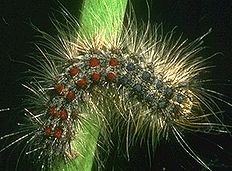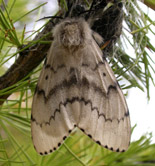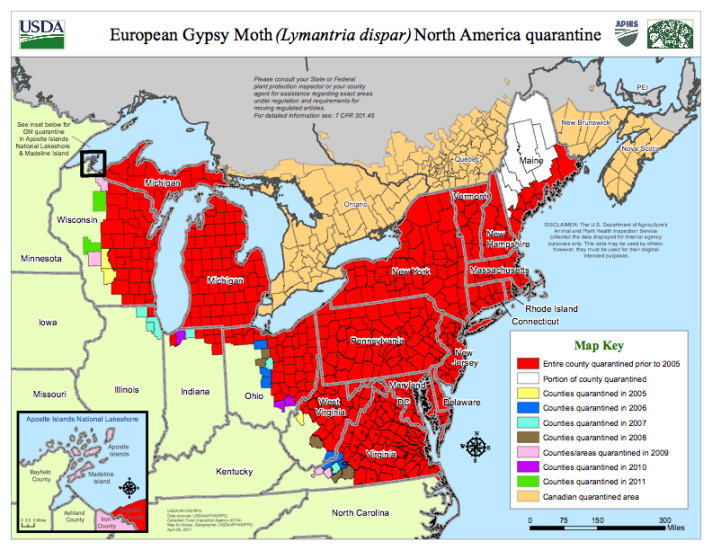From the USDA Forest Service's Forest Health Program:
Gypsy moth, a non-native invasive species introduced into Massachusetts 135 years ago, has spread southwest and  now is established in about one third of the potentially susceptible habitat in the United States. Defoliation caused by gypsy moth caterpillars may cause tree mortality, affect human health and be a nuisance. When gypsy moths first move into an area, there are significant impacts for the first 10-20 years. In areas that have had gypsy moth for many years, such as the Northeast, forests have recovered. The USDA national gypsy moth program has three strategies: Eradication, slow-the spread and suppression. The program will refocus in 2007 to accrue cost savings which will be used for other higher priority pests such as Sirex noctilio, emerald ash borer and other invasive species.
now is established in about one third of the potentially susceptible habitat in the United States. Defoliation caused by gypsy moth caterpillars may cause tree mortality, affect human health and be a nuisance. When gypsy moths first move into an area, there are significant impacts for the first 10-20 years. In areas that have had gypsy moth for many years, such as the Northeast, forests have recovered. The USDA national gypsy moth program has three strategies: Eradication, slow-the spread and suppression. The program will refocus in 2007 to accrue cost savings which will be used for other higher priority pests such as Sirex noctilio, emerald ash borer and other invasive species.
- Eradication continues to be the focus of the national gypsy moth management strategy. This vigilance and quick action has kept gypsy moth out of the western US.
- In FY 2007, Slow-the-spread will be reoriented to focus on the highest priority area, while fully implementing the program. Gypsy moth spread has been reduced by 50% along a 1,000 mile front from North Carolina to Wisconsin.
- In FY 2007, suppression efforts in the area that has had gypsy moth for many years will be reduced to focus on other higher priority pests and areas that have recently become infested with gypsy moth.
The gypsy moth, Lymantria dispar, is one of North America's most devastating forest pests. The species originally  evolved in Europe and Asia and has existed there for thousands of years. In either 1868 or 1869, the gypsy moth was accidentally introduced near Boston. About 10 years after this introduction, the first outbreaks began in Boston and in 1890 the State and Federal Government began their attempts to eradicate the gypsy moth. These attempts ultimately failed and since that time, the range of gypsy moth has continued to spread. Every year, isolated populations are discovered beyond the contiguous range of the gypsy moth but these populations are eradicated or they disappear without intervention. It is inevitable that gypsy moth will continue to expand its range in the future.
evolved in Europe and Asia and has existed there for thousands of years. In either 1868 or 1869, the gypsy moth was accidentally introduced near Boston. About 10 years after this introduction, the first outbreaks began in Boston and in 1890 the State and Federal Government began their attempts to eradicate the gypsy moth. These attempts ultimately failed and since that time, the range of gypsy moth has continued to spread. Every year, isolated populations are discovered beyond the contiguous range of the gypsy moth but these populations are eradicated or they disappear without intervention. It is inevitable that gypsy moth will continue to expand its range in the future.
The gypsy moth is known to feed on on the foliage of hundreds of species of plants in North America but its most common hosts are oaks and aspen. Gypsy moth hosts are located through most of the coterminous US but the highest concentrations of host trees are in the southern Appalachian Mtns., the Ozark Mtns., and in the northern Lake States.
Gypsy moth populations are typically eruptive in North America; in any forest stand densities may fluctuate from near 1 egg mass per ha to over 1,000 per ha. When densities reach very high levels, trees may become completely defoliated. Several successive years of defoliation, along with contributions by other biotic and abiotic stress factors, may ultimately result in tree mortality. In most northeastern forests, less than 20% of the trees in a forest will die but occasionally tree mortality may be very heavy.
Forest Effects
Despite over 100 years of presence in North America, researchers are still at a loss to explain and predict the extent of the changes in forest vegetation likely to take place through gypsy moth disturbance. A major concern is the potential loss of economically critical and ecologically dominant oak species (Quercus, spp.). Most studies of forest compositional changes with gypsy moth defoliation indicate that less susceptible species will dominate the forest, so in effect, forests may have fewer gypsy moth problems in the future.
Natural Enemies
A variety of natural agents are known to kill gypsy moths in nature. These agents include over 20 insect parasitoids and predators that were introduced over the last 100 years from Asia and Europe. Small mammals are perhaps the most important gypsy moth predator, especially at low population densities. Birds are also known to prey on gypsy moths but at least in North America this does not substantially affect populations. A nucleopolyhedrosis virus usually causes the collapse of outbreak populations and recently an entomopathogenic fungus species has caused considerable mortality of populations in North America.
Management:
Over the last 20 years, several millions of acres of forest land have been aerially sprayed with pesticides in order to suppress outbreak gypsy moth populations. Though some areas are treated by private companies under contract with land owners, most areas are sprayed under joint programs of state governments and the USDA Forest Service. Your local extension service can provide more detailed information about programs in your area.
The USDA, State and local governments also jointly participate in programs to locate and eradicate new gypsy moth populations in currently uninfested areas. Most of these projects focus on populations of European origin, but recently several Asian populations have been discovered and eradicated in the US and Canada.
In 1992, the USDA Forest Service began a pilot program to test the feasibility of slowing the spread (STS) of the gypsy moth in North America. STS pilot programs currently exist in North Carolina, Virginia, West Virginia, and Michigan.
Research:
The gypsy moth has been intensively studied over the last 100 years in North America. Currently there are numerous groups around the country investigating various aspects of the biology, ecology, and management of the gypsy moth. This work is funded by the USDA Forest Service, the USDA Agricultural Research Service, the USDA Cooperative State Research Service, the USDA Animal and Plant Health and Inspection Service, and numerous state and private Universities.
Map of Gypsy Moth Quarantine Areas by County


